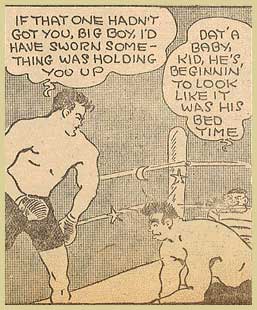'Kid Dugan'.
Dick Dorgan was an American cartoonist, comic artist and illustrator, who was mainly active in the 1920s and 1930s. He was born Richard W. Dorgan in San Francisco, California. His oldest brother was well-known cartoonist Tad Dorgan, while his other brother was bookbinder and boxing manager Ike Dorgan. He went to New York City to study at the National Academy (1910-1911) and the Art Students League (1912-1913). He sold his first cartoons to The New York Call in 1913, and later also to The Lamb: A Magazine of Fun and Finance. One of his earliest syndicated comic strips was 'Not Now', that ran through the Adams Newspaper Service in 1916.
Dorgan served in the US Navy during World War I, and produced artwork for The Broadside: A Journal for the Naval Reserve Force. This included cartoons, a comic strip and illustrations for the 'Biltmore Oswald' stories by Thorne Smith. He eventually settled in Bayside, New York. He got a regular job illustrating the syndicated column 'Ring Lardner's Weekly Letter' for The Bell Syndicate from 1919 to 1927. From 1923 to 1926, Dorgan and Lardner also cooperated on the comic strip 'You Know Me Al', previously drawn by Will B. Johnstone. When Lardner left the strip, the feature evolved into Dorgan's daily panel about the boxer 'Kid Dugan'. Around 1929, the title was changed to 'Divot Diggers', and the feature was continued by Vic Forsythe (1931-1933 and 1937-1938) and then Pete Llanuza (1933-1936), Mo Leff (1936-1937) and Henry Formhals (1938-1941) as a topper to the 'Joe Jinks' Sunday comic.
By 1922, Dorgan was also writing illustrated "slang reviews" of current moving pictures for Photoplay Magazine. As a cartoonist, he was especially known for his sports cartoons, that appeared in papers like The Daily Review. One of his best-known features was the daily panel about 'Colonel Gilfeather', which was clearly inspired by Gene Ahern's 'Our Boarding House'. It was published through the Associated Press Feature Service in about 80 newspapers since the early 1930s. Dorgan left the strip to a young artist named Alfred Caplin (Al Capp) in 1932, who was succeeded by apprentice artist Milton Caniff six months later. For Syndicated Features, Dorgan subsequently created 'Pop's Night Out', which ran from July 1936 to March 1937.





